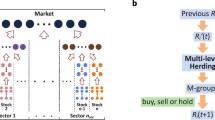Abstract
We present a detailed study of the statistical properties of the Agent Based Model introduced in paper I [Eur. Phys. J. B, DOI: 10.1140/epjb/e2009-00028-4] and of its generalization to the multiplicative dynamics. The aim of the model is to consider the minimal elements for the understanding of the origin of the stylized facts and their self-organization. The key elements are fundamentalist agents, chartist agents, herding dynamics and price behavior. The first two elements correspond to the competition between stability and instability tendencies in the market. The herding behavior governs the possibility of the agents to change strategy and it is a crucial element of this class of models. We consider a linear approximation for the price dynamics which permits a simple interpretation of the model dynamics and, for many properties, it is possible to derive analytical results. The generalized non linear dynamics results to be extremely more sensible to the parameter space and much more difficult to analyze and control. The main results for the nature and self-organization of the stylized facts are, however, very similar in the two cases. The main peculiarity of the non linear dynamics is an enhancement of the fluctuations and a more marked evidence of the stylized facts. We will also discuss some modifications of the model to introduce more realistic elements with respect to the real markets.
Similar content being viewed by others
References
V. Alfi, M. Cristelli, L. Pietronero, A. Zaccaria, Eur. Phys. J. B, DOI: 10.1140/epjb/e2009-00028-4
T. Lux, M. Marchesi, Nature 397, 498 (1999)
T. Lux, M. Marchesi, International Journal of Theoretical and Applied Finance 3, 675 (2000)
E. Samanidou, E. Zschischang, D. Stauffer, T. Lux, Rep. Prog. Phys. 70, 409 (2007)
C.H. Hommes, in Handbook of Computational Economics, edited by K.L. Judd, L.S. Tesfatsion (North-Holland Elsevier, Amsterdam, 2006)
B. LeBaron, in Handbook of Computational Economics, edited by K.L. Judd, L.S. Tesfatsion (North-Holland Elsevier, Amsterdam, 2006)
V. Alfi, L. Pietronero, A. Zaccaria, e-print arXiv:0807.1888 (2008)
G. Grimmett, D. Stirzaker, Probability and random processes (Oxford University Press, Oxford, 2004)
M. Takayasu, T. Mizuno, H. Takayasu, Physica A 370, 91 (2006)
T. Mizuno, H. Takayasu, M. Takayasu, Physica A 382, 187 (2007)
I.I. Gihman, A.V. Skorohod, The theory of stochastic processes (Springer-Verlag, New York, Heidelberg, Berlin, 1974)
R. Cont, Quant. Finance 1, 223 (2001)
B. LeBaron, in Medium Econometrische Toepassingen (MET) (Erasmus University, 2006)
M. Kreps, A Course in Microeconomic Theory (Princeton University Press, 1990)
R.N. Mantegna, H.E. Stanley, An Introduction to Econophysics: Correlation and Complexity in Finance (Cambridge University Press, New York, NY, USA, 2000)
J.P. Bouchaud, M. Potters, Theory of Financial Risk and Derivative Pricing: From Statistical Physics to Risk Management (Cambridge University Press, 2003)
A. Joulin, A. Lefevre, D. Grunberg, J.-P. Bouchaud, e-print arXiv:0803.1769
S. Mike, J.D. Farmer, J. Economic Dynamics and Control 32, 200 (2008)
Author information
Authors and Affiliations
Corresponding author
Rights and permissions
About this article
Cite this article
Alfi, V., Cristelli, M., Pietronero, L. et al. Minimal agent based model for financial markets II. Eur. Phys. J. B 67, 399–417 (2009). https://doi.org/10.1140/epjb/e2009-00029-3
Received:
Revised:
Published:
Issue Date:
DOI: https://doi.org/10.1140/epjb/e2009-00029-3




